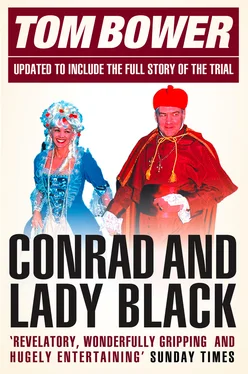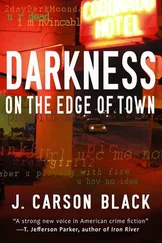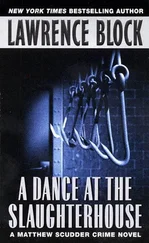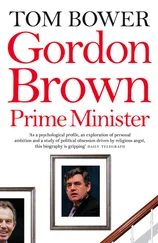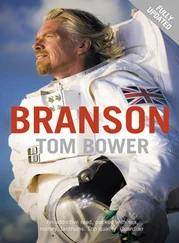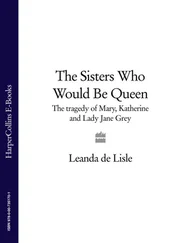Once it was agreed and signed, Black had no intention of allowing the verdict to remain unchallenged. Those who asked Black about the saga were regaled by tales of his victory as a witness against Anderson’s lawyers. Later, going further into fantasy, he described in his autobiography how, at the end of his testimony, Judge Manos had invited him into his chambers and gushed, ‘In twenty years as a judge, you are the finest witness I’ve ever had in my court. Whatever my verdict, from what I’ve seen this week, it won’t reflect unfavourably on you as a witness.’ 36 Not surprisingly, Manos had no recollection of such a bizarre encounter, but seeing the story in print convinced Black that his critics had been silenced.
The settlement in America was a relief. In Canada, however, the process continued. The investigators, Black knew, were considering charges, and were determined to send him to prison. 37 Assiduously, he began working among Toronto’s establishment to terminate the embarrassment. He prided himself on smooth-talking the regulators into accepting that he was blameless, and shoving newspaper critics aside with the brash, self-confident quip: ‘These people are demagogues of the marketplace without a stake in anything.’ 38 But his oratory was unexpectedly ineffective.
Black had become a target of hate among a section of Toronto society. The ‘Black Factor’ mentioned by a critical analyst was cited as evidence that Black was merely a manipulator of shares, rather than a master of management. 39 Bankers distrusted his restructuring of the share ownership of his companies, which gave him control without a majority of shares; some institutions questioned whether he had any motives other than self-enrichment, which he barely denied; antagonistic politicians were suspicious of his assumption of special influence among power-brokers; some journalists suspected his assertion of his own special position; others criticised his complete lack of managerial experience, including at the Sherbrooke Record , which was actually run by Radler; and journalists repeated the government’s announcement that the police investigation was ‘ongoing’. In reply, Black categorised some of his critics as the hard, political left, and others as the ‘grumbling detritus of the Establishment Old Guard in the billiard room of the Toronto Club’, due for an early appointment with the undertaker.
Fighting for his reputation, he hired Eddie Greenspan, a criminal lawyer, and accused his critics of waging a vendetta against him. He conjured up conspiracies between the American regulators, the prosecutors, the police and all his critics. Convinced that his telephones were being illegally bugged, he approached Paul Godfrey, a senior member of Toronto’s Police Commission, and demanded that the investigators should be investigated, rather than himself. No bugs were discovered. He then told Roy McMurtry, the Attorney General, to stop the feud against him, but to his surprise he was ignored.
The investigation, Black decided, could only be defeated by using the media. Summoning journalists, he explained that he was fighting not for himself but for the poor underdogs who lacked the money to defend themselves against similar ‘injustice’. His refusal to cower and hide, he repeated, was provoking the investigators’ conviction of his guilt. ‘It’s the fascistic mentality of an element of the police,’ he opined. The police, he continued, were behaving like ‘Kafkaesque, Orwellian, Koestlerian thugs’. 40 The imagery of ‘Conrad Black – The People’s Champion’ attracted some publicity: and then came the stunt.
In the midst of the investigation Black invited John Fraser, his old school friend, for lunch at Winston’s, Toronto’s best restaurant. As the two men entered, Black saw a slew of the city’s power-brokers – politicians, newspaper publishers and bankers – scattered across the room. ‘Half this restaurant already imagines me wearing a prison suit,’ he growled to Fraser. Sitting with his back to the crowd, he spotted a cockroach above Fraser’s head. ‘Ariana!’ he bellowed, calling the manager. ‘Look at that cockroach! I told you that if you let McMurtry in here I wouldn’t give you my business.’ The whole restaurant burst out laughing. 41 Black was a master of theatrics. As the laughter died away, he quietly confessed to Fraser, ‘The whole trauma sometimes stops me getting out of bed.’
The police were unimpressed. Nine criminal charges were drawn up against Black, endorsed by the Attorney General. Until the last moment it seemed that Black would be indicted and tried. He was perilously balanced on the brink. But, literally at the last minute, during a midnight meeting on 9 July 1982, the charges were dropped. The reasons were never explained. Black was ecstatic. ‘I have been absolutely exonerated,’ he exclaimed the following morning, adding, ‘There’s not one shred of evidence of any kind.’ Overnight, he resumed his stance as the master of cool. ‘The jackals and piranhas smelled blood,’ he quipped. ‘They thought they had me, that I was about to go up the chimney in a puff of smoke. [But] I never had any fears how it was going to end up. It’s all atmospherics in the United States. They never believed a goddamn word of all that bunk about racketeering.’ 42 Behind the reasonableness was real anger towards those who refused to accept his distortions. In particular, he accused Roy McMurtry of being ‘malicious as well as pusillanimous and incompetent’, 43 and he damned Linda McQuaig, a Canadian journalist who had revealed details of the police investigation. ‘I thought McQuaig should have been horsewhipped,’ he commented, ‘but I don’t do those things myself and the statutes don’t provide for it.’ 44 Losing the battle in Cleveland had furnished him with a lesson. ‘For years,’ he later told a Canadian, ‘I wondered what the difference between Canada and the United States really was – apart from the French Canadians and the monarchy. Now I know. This is a gentle place, and that’s a real hardball league down there.’ 45 As the heat diminished, his self-confidence returned. ‘Tittle tattle,’ he told questioners dismissively. ‘It’s all unimportant.’
Black’s poise was vindicated by Bob Anderson’s agreement in late July 1982 to a settlement. Wiping away the blood, Black thought that he emerged the victor. He paid a further $90 million to become Hanna’s dominant shareholder, bringing the total price to $130 million. * Anderson became a director of Norcen and Black became a director of Hanna. Pertinently, the investment would prove to be disastrous. Hanna did not fulfil Black’s expectations, and the company’s share price tumbled. The Humphreys had the last laugh. By then, Black’s bandwagon had moved on.
Conrad Black emerged having perfected an infallible method for removing the stains on his reputation. As a prolific student of biography, he knew that general impressions were more important than unfavourable details. The trick was to offer reasonable explanations, persuasively interpreting the worst in a more positive light. Over dinner with old friends, he spoke of rewriting his father’s failings, boasted about his theft of the school exam papers as ‘my first true act of capitalism, but no big deal’, and praised Radler’s ruthlessness in sacking newspaper employees. ‘The lobsters don’t get up and walk out of the tank,’ he laughed, enjoying a quip he would use many times thereafter. To propel his self-promotion he had given regular access over the previous years to Peter Newman, the editor of Maclean’s . Every Dr Johnson, thought Black, requires a Boswell. Newman, he recognised, was intelligent but awestruck. The resulting biography, called The Establishment Man , published in October 1982, suited Black’s purpose, not least because it was well written and favourably reviewed. ‘The biggest blow job in Canadian history,’ commented Larry Zolf, a television presenter.
Читать дальше
